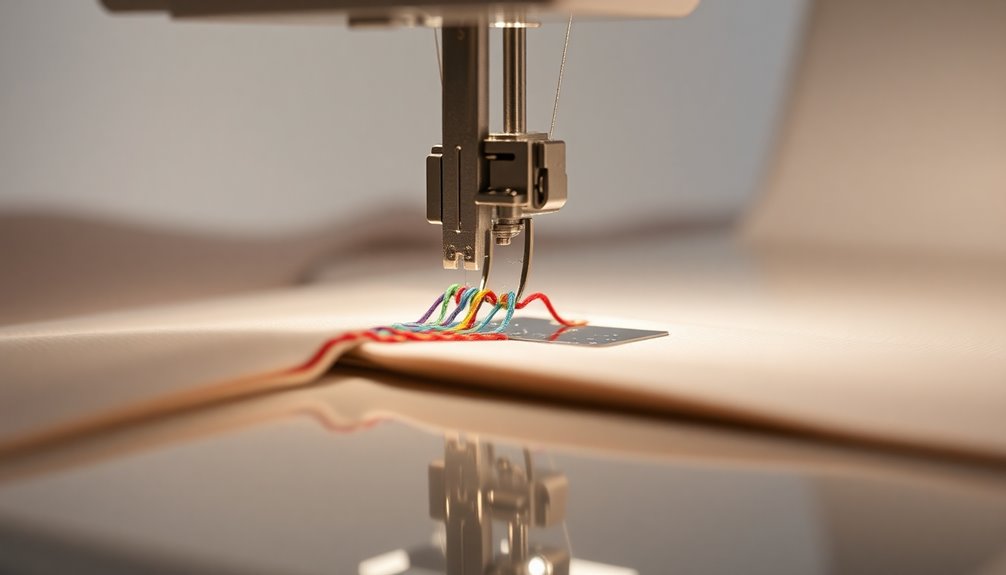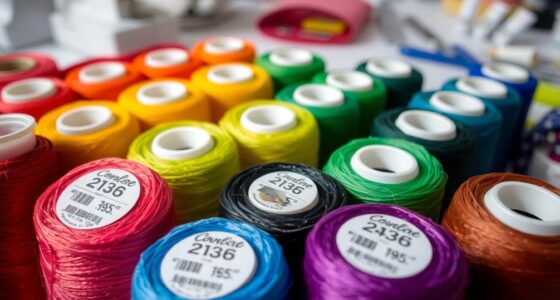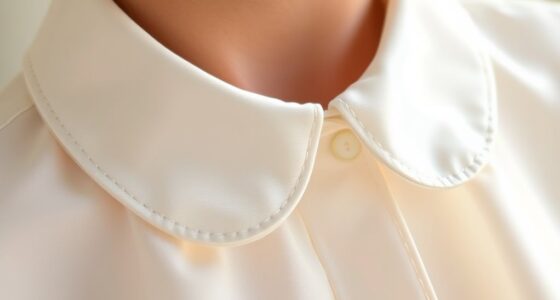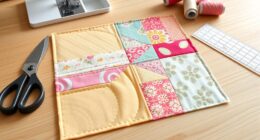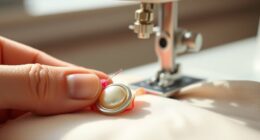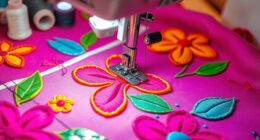The strongest stitch on a sewing machine is the lock stitch. It interlocks two threads to create durable seams, perfect for various fabrics and high-stress situations. You can also enhance strength by using heavier threads like 1. 00 mm polyester and selecting seam types, such as herringbone or saddle stitches. Understanding stitch density and fabric compatibility is key to achieving longevity in your projects. Stick around to discover more about choosing the ideal stitches for your needs. Additionally, when exploring various sewing techniques, it’s essential to also consider complementary methods like crochet stitches with minimal yarn use. This approach not only conserves materials but can also add decorative elements to your projects without compromising strength. By mastering both sewing and crochet, you can create truly unique items that are both functional and aesthetically pleasing.
Key Takeaways
- The saddle stitch is one of the strongest options, providing exceptional durability through its two-thread structure.
- Lock stitches are commonly used in sewing machines, offering strong, interlocked seams suitable for various fabrics.
- For high-stress applications, double felled seams and herringbone stitches excel in strength and reinforcement.
- Using a high-strength polyester thread, ideally 1.00 mm thick, significantly enhances seam durability.
- A stitch density of 5 stitches per inch is recommended to ensure resistance to wear and tear.
Understanding Stitch Strength
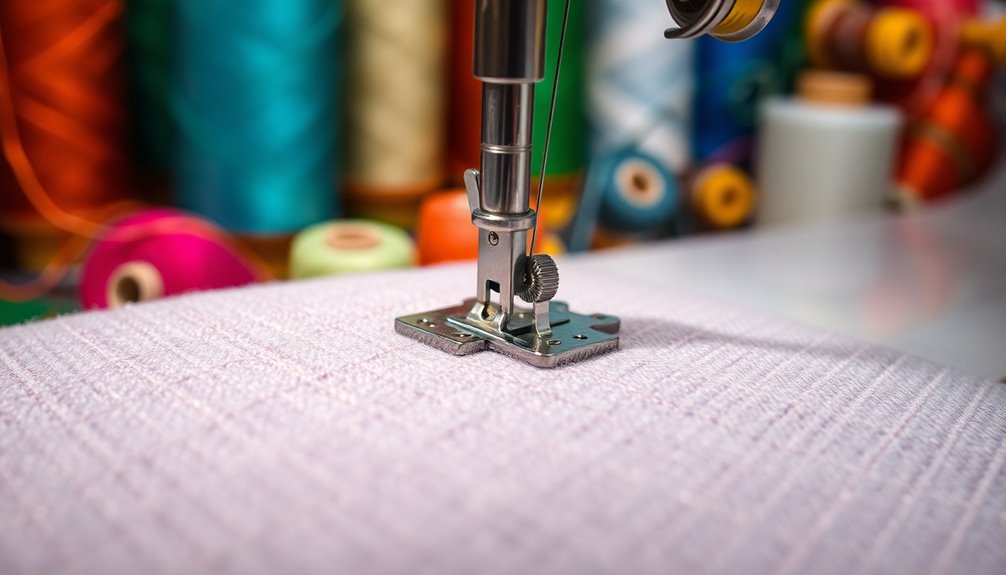
When it comes to sewing, stitch strength is essential for the durability and longevity of your projects. The strength of the stitches you use directly impacts how well your seams hold up under stress.
For instance, the saddle stitch stands out as one of the strongest due to its two-thread structure that locks securely in place. Additionally, seam types matter; felled seams and double felled seams provide superior durability compared to butt seams.
Choosing a heavier thread, like 5 spi, 1.00 mm polyester, can further enhance seam strength. Don't forget that the material you're sewing also plays a role; coarse threads in herringbone stitches can offer extra reinforcement for high-stress situations.
Understanding these factors helps you select the best stitches used for your projects.
Types of Stitches
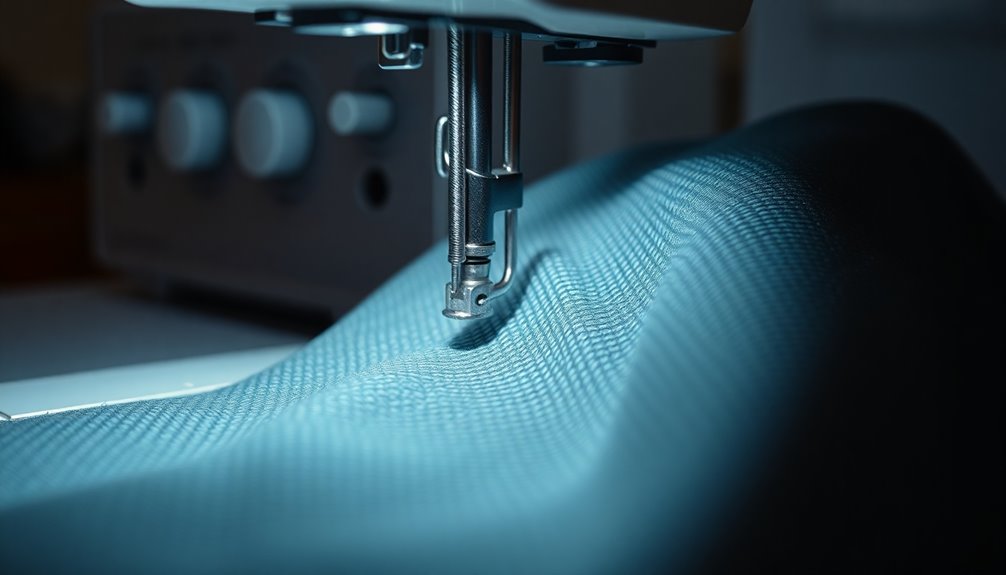
When you start sewing, understanding the different types of stitches is essential.
Basic stitch types like straight and zigzag serve various purposes, while advanced techniques can offer added strength and creativity.
Let's explore how each stitch can impact your sewing projects.
Basic Stitch Types
Stitches form the backbone of sewing, each type serving a unique purpose to enhance your projects.
The straight stitch is the most common and versatile stitch, perfect for sturdy fabrics like cotton and denim. You'll find it essential for basic seams and hems.
Zigzag stitches offer flexibility and stretch, making them ideal for sewing stretchy fabrics such as jersey or lycra.
The back stitch secures seams and locks stitches into place, preventing loose threads.
For decorative flair, top stitches add visual appeal above hems, while fancy stitches like satin and other decorative options release your creativity, allowing for unique designs and embellishments.
Mastering these basic stitch types gives you a solid foundation for all your sewing endeavors.
Advanced Stitch Techniques
While mastering basic stitches lays a solid foundation, exploring advanced stitch techniques can elevate your sewing projects to new heights.
The saddle stitch is often considered one of the strongest, featuring two running stitches made with a single thread, ensuring exceptional durability.
The herringbone stitch, or baseball stitch, is another powerful option, with its interlocking pattern enhancing seam integrity for high-strength applications.
For heavy-duty projects like denim, a double felled seam is renowned for its strength, enclosing raw edges effectively.
Additionally, the lock-a-matic stitch automatically secures seams to prevent unraveling, boosting overall strength.
Using coarse thread, like 0.8 mm to 1.0 mm, with strong stitches like herringbone greatly increases durability, making it perfect for heavy materials.
The Lock Stitch Explained
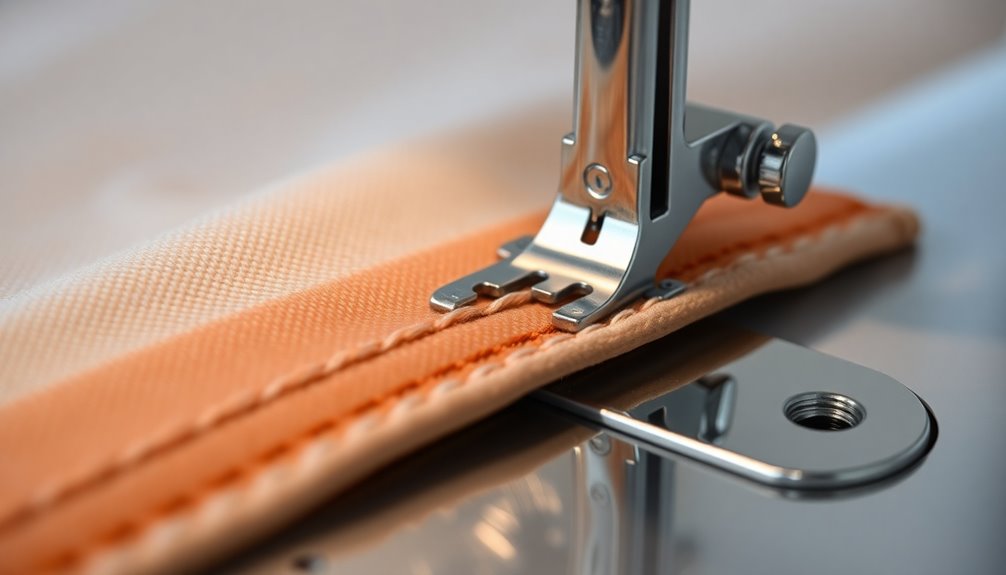
The lock stitch is a staple in sewing, thanks to its ability to create strong, durable seams.
You'll find it works well on a variety of fabrics, making it perfect for everything from garments to quilts.
Plus, its adjustable tension and length give you the flexibility to customize your stitching for any project.
Lock Stitch Characteristics
Lock stitches are a fundamental element of sewing, known for their strength and reliability. This stitch is created by interlocking two threads: the needle thread from the top and the bobbin thread from the bottom.
You'll find that lock stitches are commonly used in most sewing machines, making them the standard for general sewing tasks. Their durability suits a variety of fabrics, and they're less likely to unravel compared to other stitch types.
This makes the lock stitch ideal for seams under stress or tension. It's especially effective for straight seams, often used in garment construction and quilting.
Applications of Lock Stitch
One of the most versatile stitches in sewing, the lock stitch finds applications across various projects. Its strong and secure nature makes it ideal for garment construction, especially with heavy fabrics like denim. The balanced tension guarantees that the stitches look consistent on both sides, adding to the visual appeal. You can use the lock stitch for straight stitching, zigzag stitching, and even decorative purposes. However, it's essential to choose the right needle and thread size to maintain its integrity.
| Application | Description | Best Fabric Types |
|---|---|---|
| Garment Construction | Essential for creating durable seams | Cotton, Denim |
| Decorative Stitching | Adds visual appeal and detail | Lightweight Fabrics |
| Zigzag Stitching | Prevents fraying on edges | Knits, Stretch Fabrics |
| Quilting | Provides strong, consistent seams | Batting, Quilting Cotton |
Factors Affecting Stitch Strength
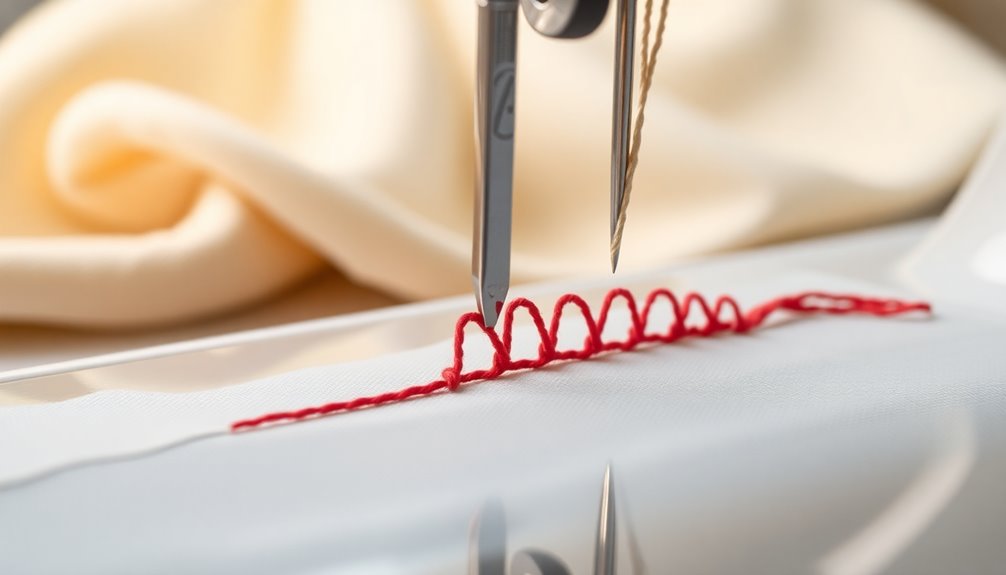
When considering the strength of a stitch, several factors come into play that can considerably impact its durability. The type of seam you choose is vital; for instance, handsewn saddle stitches often outperform many machine stitches due to their construction.
Your choice of thread matters too—using a 5 spi, 1.00 mm polyester thread can enhance seam strength, as polyester typically outlasts nylon or linen.
Keep in mind the intended use of your item; shear loading and lateral pulling on seams can increase stress, making stronger stitches necessary for items under tension.
Also, remember that thread strength can exceed the material's, which could lead to fabric failure, emphasizing the importance of ideal thread and fabric combinations.
Best Practices for Strong Seams
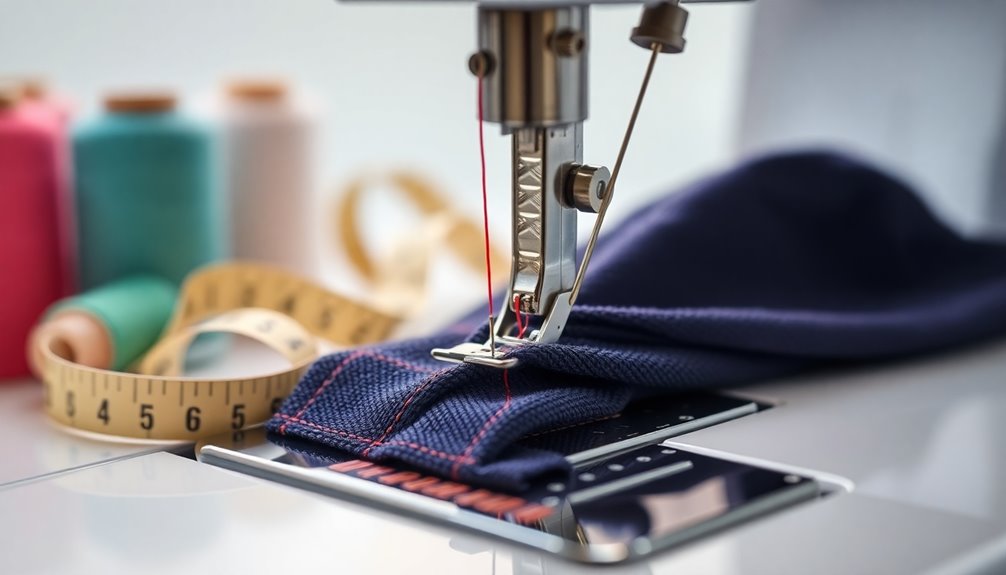
To achieve strong seams, you should focus on using the right techniques and materials.
Start by employing double-needle techniques like the double felled seam, especially for heavy fabrics, as they create the strongest seams.
Opt for high-strength polyester thread, ideally 5 spi and 1.00 mm thick, to greatly boost seam durability.
Incorporating construction techniques, such as gluing the inside of your stitching, adds extra strength and prevents seam failure.
Choose seam types wisely; herringbone and saddle stitches excel in high-stress applications.
Finally, verify your sewing machine has the correct tension settings and stitch length, as shorter stitches often lead to the strongest seams.
With these practices, you'll create seams that stand the test of time.
Comparing Stitch Types for Durability
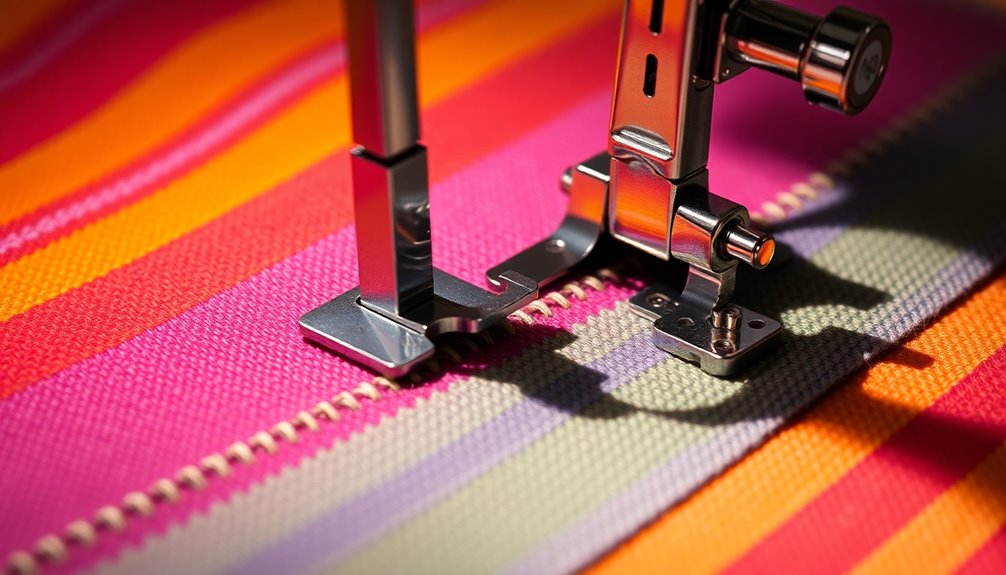
While there are numerous stitch types available, not all offer the same level of durability for your projects. The saddle stitch stands out due to its unique construction, using two running stitches with a single thread, making it stronger than most machine stitches.
For high-strength applications, the herringbone stitch, also known as the baseball stitch, provides excellent durability in seams. Additionally, the type of seam you choose greatly affects overall strength; felled seams and French seams are stronger than standard butt seams.
When aiming for robust stitches, opt for a 5 spi with a 1.00 mm polyester thread, as it's generally stronger than nylon or linen. Coarse threads between 0.8 mm and 1.0 mm are ideal for herringbone stitch applications.
Common Applications of Strong Stitches
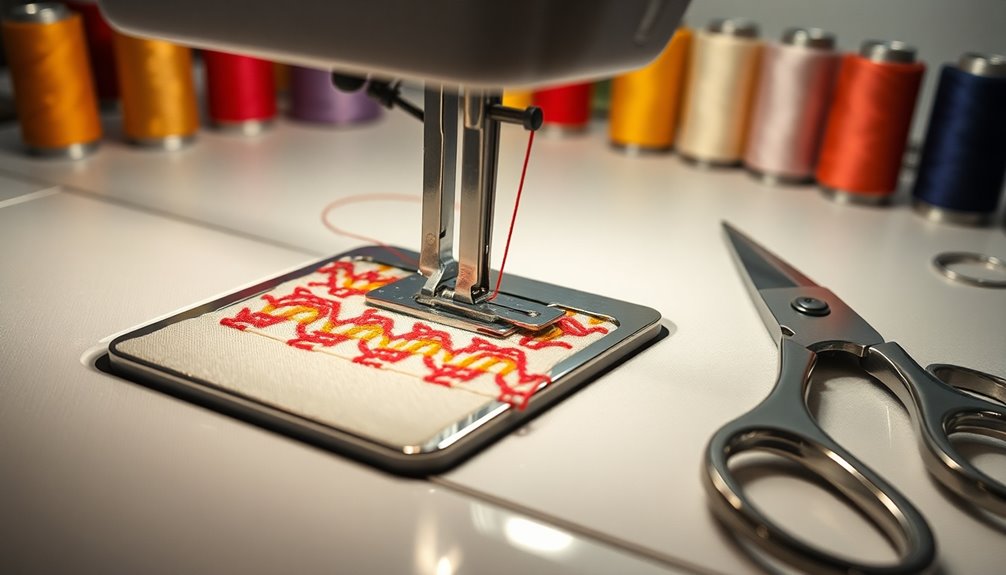
Strong stitches play an essential role in various sewing applications, guaranteeing your projects not only look good but also stand the test of time.
For basic seams in garments, the straight stitch is one of the strongest options available on sewing machines, perfect for sturdy fabrics like cotton and denim.
When working with stretchy materials like jersey, the zigzag stitch allows flexibility without compromising durability, ideal for activewear.
The lock-a-matic stitch secures seams automatically, preventing unraveling and enhancing longevity.
For heavy-duty projects, the herringbone stitch reinforces seams while adding a decorative touch.
Finally, the triple stretch stitch is excellent for quilting, providing strength and flexibility when assembling multiple layers.
Using these stitches guarantees your creations remain intact and functional.
Recommended Tools and Materials

When commencing on projects that require strong seams, you'll want to gather specific tools and materials to guarantee your creations hold up over time.
Here are some essentials:
- 1.00 mm polyester thread for durability and strength.
- 1050D Cordura ballistic nylon for robust material in high-stress applications.
- Size 90/14 or 100/16 needles to accommodate thicker threads.
- Fabric glue to enhance seam strength along the inside.
Using a stitch density of 5 stitches per inch assures that your seams can withstand wear and tear.
Coarse threads, like those in herringbone stitches, provide additional support.
Tips for Beginners in Stitch Selection
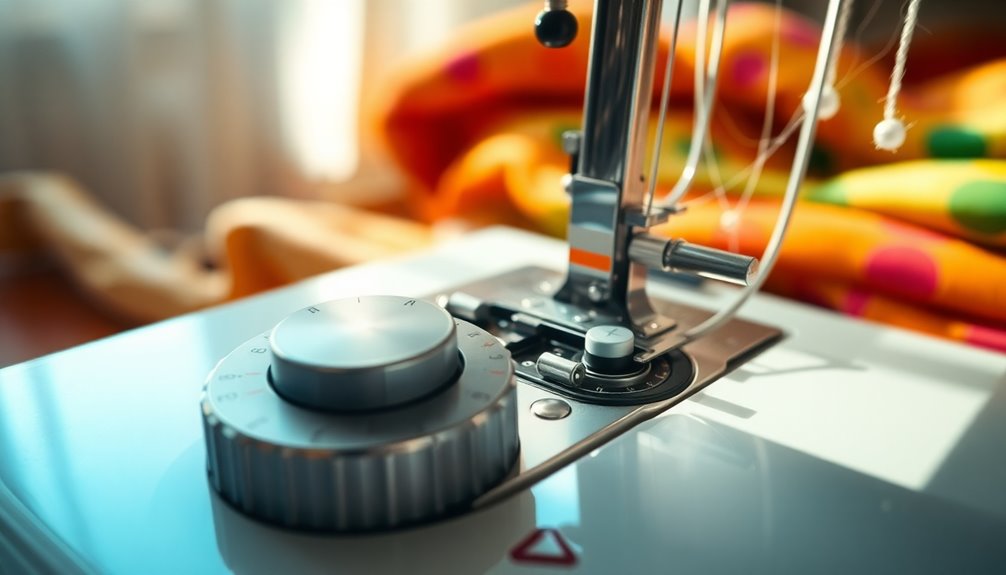
Choosing the right stitch can make all the difference in your sewing projects, especially for beginners. Start by understanding the strength and stretch of your fabric—use zigzag stitches for stretchy materials while opting for straight stitches on non-stretchy ones.
Familiarize yourself with your sewing machine's options; stitches like the lock-a-matic and triple stretch provide added durability for seams. Begin with basic stitches like the straight stitch to build your confidence before moving on to decorative ones.
Always consider your project's purpose; for heavy-duty tasks, stitches such as the herringbone or saddle stitch are reliable choices.
Finally, test your selected stitch on a scrap piece of fabric to verify it meets your strength requirements before diving into your main project.
Frequently Asked Questions
What Is the Strongest Stitch on a Sewing Machine?
When you're looking for the strongest stitch on a sewing machine, you'll want to evaluate the triple stitch or lock stitch. These stitches create secure seams with three needle penetrations.
If you're working with stretchy fabrics, a zigzag stitch offers flexibility and strength. For non-stretch materials, a well-executed straight stitch works well, especially with the right thread and needle.
Don't forget the saddle stitch for leather, which is incredibly durable!
What Is the Toughest Stitching?
When you think about the toughest stitching, consider the saddle stitch. It's a hand-sewing technique that interlocks two threads, giving you incredible strength.
If you're working with a sewing machine, try the lockstitch or the triple stretch stitch for heavy materials. These options create secure seams that withstand tension well.
Pairing these stitches with strong thread, like polyester, will further enhance durability and keep your projects intact under stress.
Which Is Stronger, Straight or Zigzag Stitch?
So, you think picking between straight and zigzag stitches is like choosing a favorite child?
Well, straight stitches are your go-to for strength in non-stretch fabrics, holding up like a champ under pressure.
Zigzag stitches? They're the flexible best friend, perfect for stretchy materials.
If you're sewing denim, straight's your hero; for knits, zigzag saves the day.
Ultimately, it's about knowing your fabric and what your project demands—no superhero cape required!
What Is the Strongest Repair Stitch?
When you're looking for the strongest repair stitch, consider the zigzag stitch. It's flexible and great for stretchable fabrics, maintaining seam integrity.
If you're working with leather or high-stress areas, the saddle stitch is unbeatable due to its two-thread construction.
For added durability, try a reinforced straight stitch or a locking stitch to prevent unraveling.
Conclusion
To summarize, knowing the strongest stitch for your sewing projects can make a world of difference. Did you know that a properly executed lock stitch can withstand a tensile strength of up to 40 pounds per square inch? That's like hanging a 20-pound bag of flour from a single seam! By applying the best practices and selecting the right tools, you'll guarantee your seams are not just strong but also durable, making your sewing creations last.
